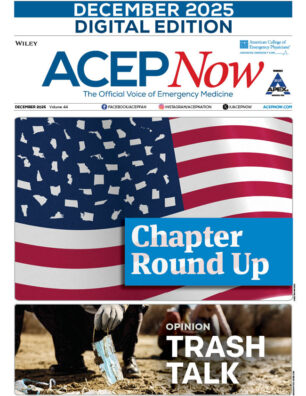1) Endpoints of Therapy: More is Not Always Better
EMS providers may encounter patients with complete or partial opiate toxidromes, with multiple drug exposures, or at various stages of overdose. This variability is important to consider when discussing endpoints of naloxone therapy.
Apnea management with bag valve mask ventilation and opiate reversal is the sine qua non of naloxone administration. Increased opiate potency with the addition of fentanyl adulterants can substantially increase the amount of naloxone required for apnea reversal. In one EMS study, the percentage of patients receiving multiple doses of naloxone increased from 14.5 percent in 2012 to 18.2 percent in 2015.1 Recent reports have found that 20 mg of naloxone may be needed to reverse profound overdose effects.
When patients present with complete opiate toxidromes (syndromes caused by dangerous levels of toxins in the body) and EMS providers have a high index of suspicion for opiate-induced apnea (such as apnea with pinpoint pupils), the use of multiple naloxone doses may be a legitimate strategy. In contrast, the use of multiple naloxone doses to reverse opiate-induced altered mental status and completely wake the patient may be harmful, especially when it is associated with anchoring bias. While partial response to an initial dose may indicate the need for additional naloxone, partial responses may also suggest the presence of an alternative etiology or a mixed presentation. The use of large naloxone doses in the setting of partial toxidromes, multiple drug exposures or diagnostic uncertainty may harm the patient and compromise EMS provider safety by inducing agitation, exacerbating other co-existing diseases, and delaying recognition of other emergencies.
2) Adverse Effects of Acute Withdrawal: They Can Be Serious
Rapid opiate reversal with naloxone may induce acute opiate withdrawal and precipitate severe cardiovascular, neurological, and behavioral emergencies. Lameijer et al described a case of ventricular tachycardia following naloxone administration and suggest that patients with mixed presentations or exposure to large opiate doses are more prone to developing ventricular tachycardia or ventricular fibrillation.2 When acute withdrawal is induced in the setting of chronic opiate overdose with acute toxicity of non-opiate drugs or an acute medical emergency, the withdrawal state may exacerbate the toxicity or medical emergency. A slower, more cautious approach using smaller aliquots of naloxone may be more appropriate.
3) EMS Provider and Patient Safety: Avoid Chasing Your Tail
Patients may experience severe agitation following naloxone administration, which is concerning for two reasons. First, sedation may be needed to calm the patient, but may also result in hypotension, respiratory depression, or cardiac dysrhythmias. Second, agitation may compromise EMS provider safety, especially if escalation occurs during transport in the absence of law enforcement.
4) Refusal of Transport: Not All Overdose Reversals Are Straightforward
Patient refusal of transport may occur following naloxone administration if decision-making capacity has been restored. Non-transports following prehospital naloxone administration are considered relatively safe.3,4 However, since these studies, the strength and duration of action of abused substances has changed significantly. These characteristics should be accounted for when determining decision-making capacity. While most non-transports will continue to be safe, EMS providers must diligently exclude other etiologies and ensure the patient has appropriate medical decision making capacity.
5) Delayed Diagnosis and Treatment: Remember the ABCs
A final and significant potential negative consequence of multiple naloxone doses is delayed recognition and treatment of acute medical and traumatic emergencies. Hypoglycemia, severe sepsis, anaphylaxis, stroke, intracranial hemorrhage, and encephalopathy can all mimic an opioid overdose. Anchoring bias may lead to failure to diagnosis and treat alternative etiologies. Ongoing assessment of the airway to relieve or prevent airway obstruction is essential. In most cases, effective bag valve mask ventilation should take place on arrival of first responders (ie, police, fire, and EMS) and as additional doses of naloxone are prepared and administered.
Conclusion
EMS use of naloxone in opiate overdoses can be lifesaving, and in the majority of cases, the risk of iatrogenic harm is exceedingly low. However, overdoses are becoming more complex and the potential harms of multiple naloxone doses should be considered before administration.
References
- Faul M, Lurie P, Kinsman JM, et al. Multiple naloxone administrations among emergency medical service providers is increasing. Prehosp Emerg Care. 2017;21(4):411-419.
- Lemeijer J, Azizi N, Ligtenberg JJ, et al. Ventricular tachycardia after naloxone administration: a drug related complication? Case report and literature review. Drug Saf Case Rep. 2014;1(1):2.
- Wampler DA, Molina DK, McManus J, et al. No deaths associated with patient refusal of transport after naloxone-reversed opioid overdose. Prehosp Emerg Care. 2011;15(3):320-324.
- Willman MW, Liss DB, Schwarz ES, et al. Do heroin overdose patients require observation after receiving naloxone? Clin Toxicol (Phila). 2017;55(2):81-87.
Dr. Cortez is OhioHealth System associate EMS medical director at OhioHealth Doctors Hospital, clinical assistant professor of emergency medicine, and associate medical director of the Columbus Division of Fire. Dr. Casey is OhioHealth Doctors Hospital emergency medicine associate residency director, clinical assistant professor of emergency medicine, and EMS director for Springfield Regional Medical Center.
Pages: 1 2 | Multi-Page




No Responses to “5 Important Considerations for EMS Naloxone Administration”